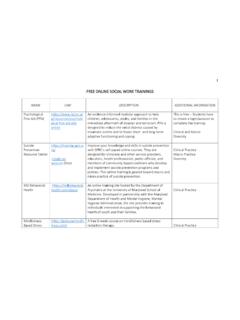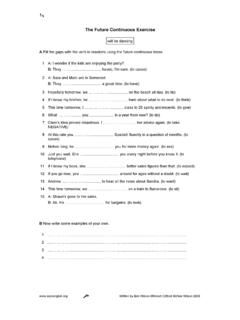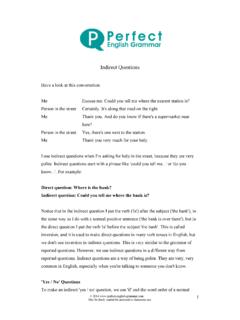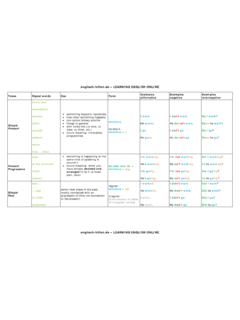Transcription of APA 7th Ed. Reference Guide - UNC School of Social Work
1 1 APA 7th Ed. Reference Guide University of North Carolina School of Social Work Revised May 2020* Prepared by Jordan Wingate Academic Editor * This resource updates the contents of the APA Quick Reference Guide prepared by Diane Wyant in 2010. 2 Table of Contents Basic Structure for APA APA Page Formatting and Formatting Tables and In-text Bias-Free Sample Student Paper Cover Sample Journal Article Cover NB: these guidelines only address the most common APA-related formatting and style questions.
2 Comprehensive guidelines are available online at: or 3 1. Basic Structure of APA Papers All papers in APA style will include these sections in the following order: 1. Cover or title page 2. Abstract (in journal articles this is sometimes followed by Keywords on the same page) 3. Body of the paper (often including Methods, Results, Discussion, and Conclusion; APA papers do not include an Introduction header they begin after the title with no header) 4. References Each of these four sections begins on its own page. For example, don t begin the body of the paper on the same page as the Abstract; start a new page.
3 However, the sections within the body of the paper should be continuous. For example, if your Discussion ends in the middle of a page, begin your Conclusion on that same page. Depending on the requirements of the class paper or the journal article, tables and figures are included either (a) in the body of the paper where you d like them to appear, or (b) after the References section. If they appear after the References, then each table/figure/appendix should appear on its own page. Also, indicate in the body of the paper where you d like them to appear by writing <Insert Table/Figure # about here> 2. APA Page Formatting and Style Margins 1 margins on all sides; text is flush left (ragged right edge) Font 12 pt.
4 Font max for main text/headings/tables/figures For main text/headings, you can choose among: Calibri (11 or 12 pt. recommended) Lucida Sans Unicode (10 pt. recommended) Arial (11 pt. recommended) Georgia (11 pt. recommended) Times New Roman (12 pt. recommended) Use one font and font size consistently for your title page, abstract, main body text, and references Tables/figures require a sans serif font: Arial, Calibri, or Lucida Sans Unicode Font size for tables/figures can be from 8 pt. to 14 pt. For computer code, use a monospace font such as Lucida Console (10 pt.) or Courier New (10 pt.) Spacing Double-spaced throughout, including references One space following all punctuation and between sentences One space between author s initials: J.
5 L. Borges Exceptions: No spaces between punctuation in abbreviations ( , ) Indentations Indent in each new paragraph, including the first paragraph Do not indent the first line of the Abstract; it should be flush left All lines of block quotations (> 40 words) are indented from the left margin Reference entries have a hanging indent 4 Page Header Page numbers appear in the upper right-hand corner; title/cover page is page 1 For journal articles, include running header in all caps in upper left-hand corner Numbers Numbers less than 10 are written out as words ( , one, two, ..nine) Numbers 10 and greater use Arabic figures (10, 11.)
6 Use % to report any percentages (4%, ) Exceptions: When you begin a sentence with a number, write out the number as a word. If it is a percentage, also write out percent ( , Twenty-six percent of ) Variables Italicize English letters used as statistical symbols or algebraic variables ( , N, n, t, M, SD, Cohen s t) Exception: When a variable that would normally be italicized appears in an italicized title, you do not italicize the variable: Demographic Characteristics of Study Participants (N = 150) For equations, put one space before and after the = Italics Italicize the first use of key terms/phrases ( , Self-care is defined ) Italicize titles of books, reports, webpages (not URLs), and other standalone works Italicize anchors of a scale, but not the associated numbers.
7 Example: ..using a Likert scale (1 = strongly disagree to 5 = strongly agree) Italicize the first use of words/phrases from another language that your reader may not know Example: ..the concept of familidad You do not need to italicize Latin terms that have become accepted as English words, such as et al., per se, a priori, ad hoc, vis- -vis, et cetera Hyphens Words that are always hyphenated: Any compound words with self- as the prefix (self-reported, self-care) Two words acting as a compound adjective (low-dosage group, 12th-grade students, a two-thirds majority) Any compound with a base that is capitalized, a number, or an abbreviation (non-Latinx, post-1990, anti-FBI rally) Do not hyphenate.
8 Racial and ethnic group names ( , Korean American) Compound adjectives that include an adverb ending in -ly ( , federally funded grant, randomly assigned groups, widely accepted terms) Compounds that include a comparative or superlative adjective ( , better written text, higher order analysis, worst case scenario) Tense Use past tense ( , studied) or present perfect tense ( , have studied) in your literature review, methods, and results sections Use present tense when discussing the implications of your results, presenting your conclusions, describing limitations of your study, and making recommendations for future studies Abbreviations When abbreviating a term, write out the full term and then follow it with the abbreviation in parentheses the first time you use it.
9 After that, just use the abbreviation ( , The School of Social Work (SSW) had a record number of applications this past year. SSW data shows ) 5 Exceptions: You do not need to write out the full term of any abbreviation that appears as a word in the Merriam-Webster s Collegiate Dictionary ( , IQ, HIV, RNA, UNESCO) Use periods when abbreviating United States as an adjective ( government) Except for inch (in.), do not use periods when abbreviating measurements (mm, lb, min, kg). Measurements should only be abbreviated when attached to a numerical value (25 kg) Do not abbreviate day, week, month, or year Quotation Marks Use quotation marks: to refer to a letter, word, phrase, or sentence as a linguistic example ( , the letter a, they answered yes ) to quote material verbatim from a source ( , a scholarly article, a test item, instructions to participants) around the title of a journal article or book chapter when it appears in the main text of your paper (no quotation marks in the references) Do not use quotation marks.
10 To highlight a key term or phrase (use italics see above) to downplay or attenuate meaning ( , participants received a gift ) Pronouns Use I if you are the sole author; do not refer to yourself as the author Use we if you are writing a paper with coauthors Do not use we to refer to people in general ( , We often do not have enough time to do everything we want to do. ) To refer to a singular person whose gender is unspecified or who is nonbinary, use they ; do not use he or she, (s)he, or s/he 3. Headings APA 7th Ed. has a revised the formatting of different levels of section headings for the main body text of papers. Always begin with level-1 headings and proceed sequentially.





